Digital preservation of Sardinian heritage uses advanced tools like satellite imagery, drone LiDAR, and digital modeling to protect its iconic Nuraghi and archaeological sites. These technologies enable non-invasive monitoring, early detection of environmental threats, and detailed documentation for restoration. Projects like NuraghEO and centers such as Li Punti enhance conservation efforts. With UNESCO recognition and strong policies, digital strategies boost cultural pride and tourism. To discover how these innovations shape Sardinia’s future, keep exploring.
Key Takeaways
- Digital technologies like satellite imagery, LiDAR, and drones enable precise, non-invasive documentation of Sardinian archaeological sites.
- 3D modeling and virtual reconstructions preserve Nuraghi and artifacts, facilitating long-term heritage conservation and public access.
- Projects such as NuraghEO monitor environmental threats and ground movements, supporting proactive preservation strategies.
- Heritage digitization enhances educational outreach, promotes sustainable tourism, and strengthens community involvement.
- Integration of GIS, remote sensing, and AI tools improves site management, risk assessment, and decision-making for Sardinian heritage preservation.
The Unique Significance of Nuraghi Structures in Sardinia
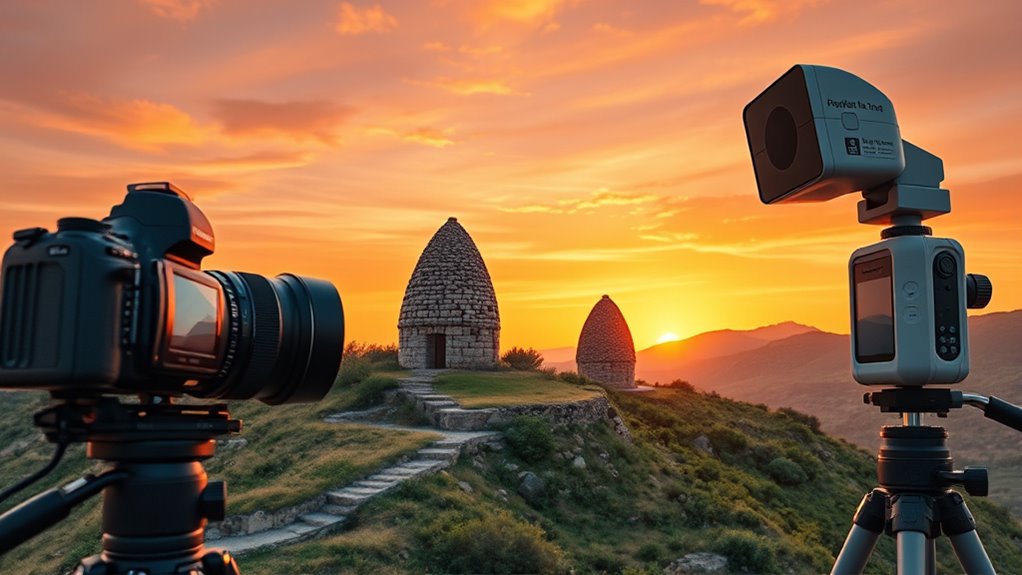
Nuraghi structures hold a special place in Sardinia’s history because they are uniquely emblematic of the island’s Bronze Age civilization. As you explore Sardinia, you’ll see over 7,000 nuraghi, each revealing the importance of these stone towers in prehistoric society. Built between the 18th century BC and the 2nd century AD by the Nuragic people, they symbolize Sardinia’s distinct cultural identity, setting it apart from mainland Italy. These structures weren’t just defensive; they often formed part of vibrant communities with villages of circular huts nearby. The UNESCO-listed Su Nuraxi exemplifies this social and political innovation. Nuraghi’s unique architecture and widespread distribution highlight their significance as symbols of Sardinian heritage, resilience, and the sophisticated craftsmanship of an ancient civilization. The Nuragic civilization remains a subject of ongoing archaeological research, which continues to uncover new insights into their complex society. Additionally, the archaeological significance of these sites helps deepen our understanding of prehistoric social organization and technological advancements.
Leveraging Digital Technologies for Archaeological Monitoring
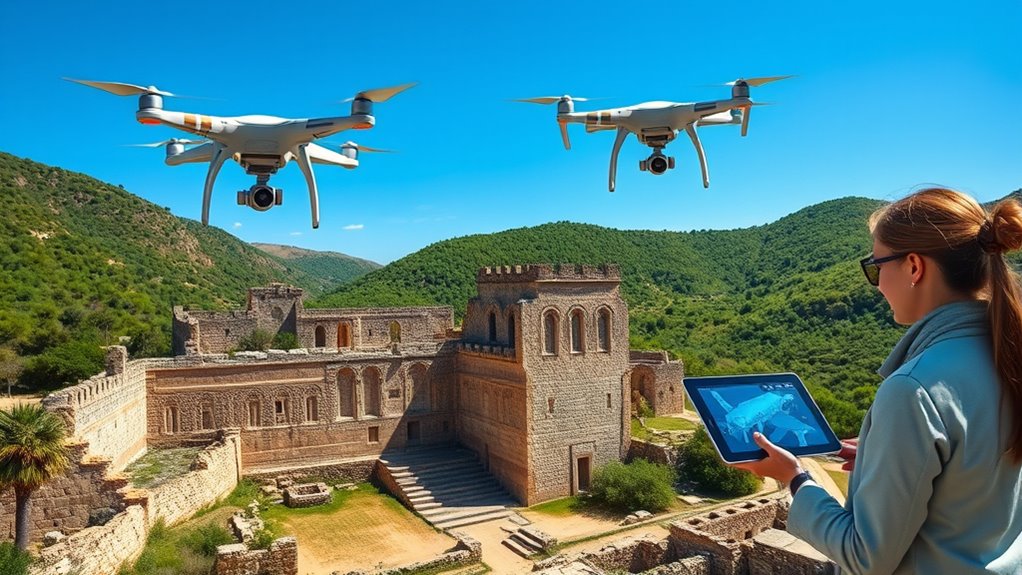
Digital technologies have transformed archaeological monitoring in Sardinia by enabling non-invasive, precise, and large-scale site analysis. You can leverage advanced remote sensing tools to monitor landscape changes and assess site visibility effectively. For example:
- Satellite imagery with high temporal and spatial resolution helps track environmental shifts impacting archaeological sites.
- Drone-mounted LiDAR uncovers hidden Nuragic and Bronze Age structures beneath dense vegetation, revealing previously unknown sites.
- Integration of multispectral data and automated analysis reduces noise and highlights microtopographical features, streamlining discovery efforts.
- The integration of these digital methods enhances data accuracy and allows for real-time monitoring and rapid response to potential threats, significantly enhancing preservation strategies.
These digital methods support targeted excavations, monitor preservation conditions, and minimize disturbance. The combination of satellite, drone, and multispectral technologies enhances your ability to conduct exhaustive, efficient archaeological surveys while safeguarding Sardinian heritage.
The Role of the NuraghEO Project in Environmental and Cultural Preservation
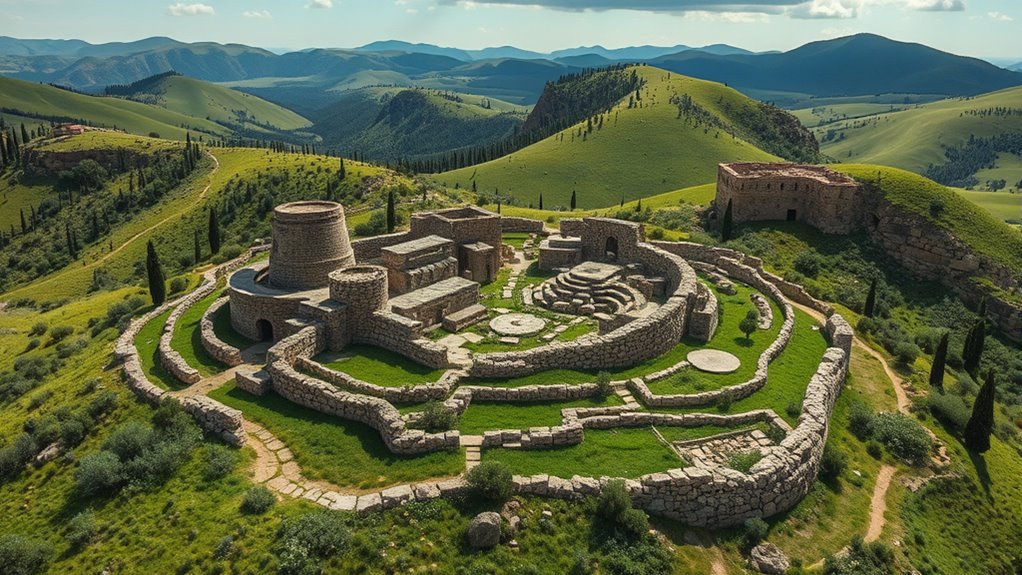
The NuraghEO project harnesses advanced territorial monitoring technologies to safeguard Sardinia’s iconic Nuraghi structures. It tracks their condition, helping prevent deterioration. By integrating satellite data and displacement tools like Rheticus, you can detect ground movements or environmental threats early. This proactive approach allows timely conservation efforts. Furthermore, GIS overlays combine environmental and cultural data, enhancing site management. NuraghEO also builds a detailed digital database of Nuragic heritage, supporting archaeological discovery and preservation. Its activities contribute to environmental assessment, ensuring natural and human impacts are monitored and mitigated. This holistic approach maintains the monuments’ structural integrity while preserving Sardinia’s cultural identity. Additionally, the project emphasizes the importance of cultural heritage preservation as a vital part of safeguarding regional identities for future generations.
The Central Role of the Li Punti Conservation Center

Located in Sassari, the Li Punti Conservation Center plays an essential role in safeguarding Sardinian archaeological heritage through its state-of-the-art facilities and specialized restoration techniques. You benefit from large, fully equipped workspaces designed for extensive projects, capable of handling over 5,000 stone fragments from Mont’e Prama. The center’s advanced diagnostic tools, such as microscopy and SEM-EDS, enable detailed material analysis. Its laser scanning technology allows for precise 3D rendering and virtual restoration. You’ll find that the restoration process involves: 1. Meticulous reassembly of fragments, from millimeters to centimeters. 2. Exhaustive documentation, including photos, videos, and databases. 3. Application of modular reconstruction techniques, like lead core pivots, to replicate architectural details. This infrastructure makes Li Punti indispensable for conserving Sardinian heritage, especially as restoration techniques continue to evolve with technological advancements.
Promoting Nuragic Heritage Through UNESCO and Local Initiatives

Efforts to promote Nuragic heritage in Sardinia are gaining momentum through UNESCO recognition and local initiatives. Su Nuraxi of Barumini, designated as a UNESCO World Heritage site in 1997, exemplifies the Nuragic civilization’s cultural genius. There are ongoing proposals to expand UNESCO’s recognition to include multiple Nuragic sites, which could boost cultural pride and economic growth. Locally, organizations like “Sardinia towards Unesco” work tirelessly to publicize Nuragic heritage across all 377 municipalities. They promote community involvement, sustainable tourism, and economic development through preservation projects. These initiatives foster a sense of identity and ensure long-term protection. Digital tools now support these efforts, documenting sites and offering virtual experiences that make Nuragic heritage accessible worldwide, strengthening Sardinia’s cultural legacy. In addition, incorporating educational programs about the Nuragic civilization can inspire future generations to value and continue preserving this unique heritage enhancing community engagement and awareness.
Policy Frameworks Supporting Heritage Preservation at National and European Levels
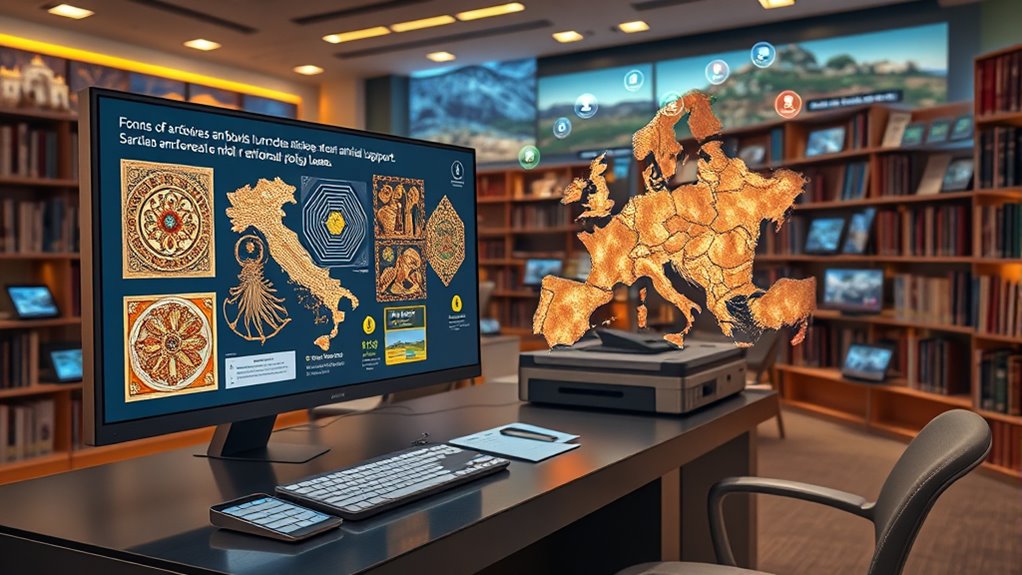
Policy frameworks at national and European levels form the backbone of Sardinian heritage preservation efforts. At the national level, Italy’s Legislative Decree 42/2004 safeguards sites like Su Nuraxi di Barumini, requiring authorization for activities and regional protection through Sardinia’s Landscape Plan. This plan enforces buffer zones, bans unsuitable construction, and mandates regional conformity to heritage standards. At the European level, policies promote sustainable development, integrating cultural heritage into territorial planning. Initiatives like the Copernicus satellite monitoring support risk assessment and conservation, while collaboration among research centers, heritage agencies, and EU frameworks fosters technology transfer and knowledge sharing. These policies align local, regional, and national actions, ensuring coordinated protection, sustainable management, and heritage valorization across Sardinia. Additionally, heritage assessment methodologies are crucial in determining the vulnerability of sites and guiding conservation priorities.
Advanced Digital Tools for Site Management and Risk Detection
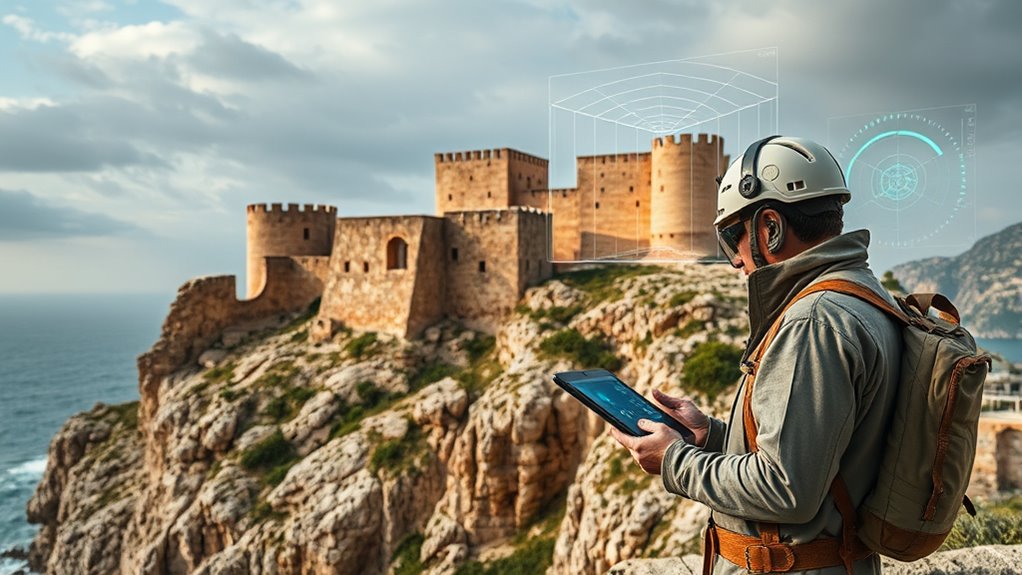
You can use satellite and drone imaging to monitor Sardinian heritage sites for environmental changes and structural risks in real time. GIS and digital models allow you to create detailed maps and simulations that support proactive site management. These advanced tools help identify threats early, enabling timely conservation actions. These technologies are increasingly adopted by cultural heritage professionals worldwide to enhance preservation efforts. Additionally, integrating digital preservation techniques can improve long-term documentation and analysis of site conditions.
Satellite and Drone Imaging
Satellite and drone imaging have revolutionized the way you monitor and manage Sardinian heritage sites by providing high-resolution, non-invasive documentation. These technologies enable detailed site analysis and early risk detection. Using advanced imaging methods, you can:
- Combine multi-temporal satellite imagery with drone data to enhance coverage and revisit frequency. This integration allows for scalable, real-time surveillance and supports informed decision-making for preservation.
- Apply AI algorithms to automatically identify structural deterioration and environmental stresses.
- Conduct continuous, large-area monitoring for threats like urbanization, natural erosion, or unauthorized activities.
- Utilize these tools to facilitate predictive modeling for future risk assessment, allowing proactive preservation measures. Drones, with their high-precision cameras and thermal sensors, assist in site mapping, environmental monitoring, and artifact authentication. Together, these tools offer a powerful, non-intrusive approach to safeguarding Sardinian heritage.
GIS and Digital Models
GIS and digital models have become essential tools for managing Sardinian heritage sites, enabling precise mapping, analysis, and monitoring of archaeological and architectural features. You can create centralized spatial databases that integrate site boundaries, land use, conservation status, environmental factors, and historical records, supporting informed decision-making. By adopting GIS infrastructures, authorities improve heritage management coordination. GIS also facilitates change detection through LiDAR, revealing erosion, subsidence, and unauthorized modifications with centimeter accuracy. Thermal imaging uncovers hidden moisture and structural stresses, while temporal data layers track vegetation encroachment and human alterations. These tools support comprehensive heritage monitoring by incorporating real-time data from remote sensing technologies. Combined with environmental data, GIS helps assess threats like flooding, pollution, and urban development. These tools enable proactive risk assessment, prioritize conservation efforts, and foster community engagement through accessible platforms, ensuring Sardinian heritage’s long-term preservation. Additionally, integrating digital modeling techniques enhances the visualization of complex structures, aiding restoration planning and public education.
The Economic and Cultural Benefits of Heritage Digitalization

Digital preservation of Sardinian heritage offers significant economic and cultural advantages. It broadens global access, attracting virtual visitors and encouraging physical tourism. By showcasing digital exhibitions and resources, you can extend visitor stays and increase spending. Additionally, heritage digitization creates jobs in technology, archaeology,, and cultural sectors. Consider these benefits:
- Boosts tourism and stimulates local economies through increased interest and spending.
- Safeguards cultural objects and traditions, promoting identity and community pride.
- Enhances conservation efforts with advanced tools like 3D modeling and remote monitoring, which are part of digital heritage preservation techniques.
- Supports data management and spatial analysis that improve decision-making and preservation strategies.
These initiatives also foster community involvement, raise awareness, and enable international collaboration. Overall, digital heritage preservation strengthens Sardinia’s cultural legacy while delivering measurable economic growth.
Future Perspectives for Sardinian Heritage Preservation and Promotion
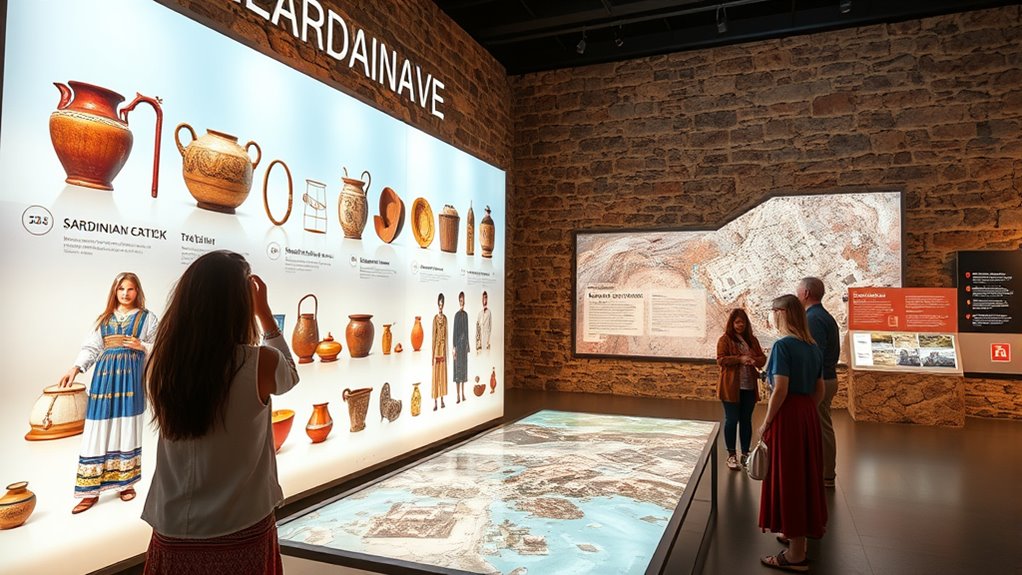
Building on the momentum of digital preservation efforts, Sardinia is increasingly focusing on strengthening legal and institutional frameworks to protect its heritage. Collaborative initiatives with UNESCO aim to secure World Heritage status for Nuragic monuments by 2025, boosting protection measures. Memorandums like Eurispes with APS La Sardegna support coordinated efforts across Italian and Sardinian institutions. National ministries such as MUR and MIC align their programs with EU policies to enhance conservation capacity, while regional governance works with frameworks like Horizon Europe to secure funding and strategic support. Future challenges include ensuring local institutions actively participate in EU-funded projects for more effective conservation tools. Technological innovations, digital platforms, and community involvement will continue to play crucial roles in safeguarding and promoting Sardinian heritage for generations to come. The portal lasardegnanellapreistoria.com further exemplifies how digital tools are transforming heritage dissemination and engagement.
Frequently Asked Questions
How Is Community Involvement Integrated Into Digital Heritage Preservation Projects?
You play a crucial role in digital heritage preservation by actively participating in projects that digitize Sardinian cultural assets. Your contributions include reporting site conditions, helping with data collection, and sharing local knowledge through user-friendly apps. By engaging in community meetings and workshops, you’re ensuring the digital documentation reflects your culture and history, fostering a sense of ownership and ensuring that Sardinian heritage stays relevant and protected for future generations.
What Challenges Exist in Implementing Digital Tools Across All Nuraghi Sites?
You face numerous challenges when implementing digital tools across all Nuraghi sites. The sheer number and diversity of sites make uniform deployment difficult, especially with varying sizes, conditions, and accessibility. Coordinating efforts across 377 municipalities complicates logistics. Limited resources, uneven digital literacy, and terrain obstacles hinder progress. Additionally, balancing scientific accuracy with engaging storytelling proves tough, all while ensuring sustainable funding and technological updates to keep digital records current and reliable.
How Do Digital Archives Ensure Long-Term Data Preservation and Access?
You might think digital archives quickly become outdated, but proactive measures prevent this. You actively monitor and update your data through regular audits, migrations, and format management. By collaborating with experts, you guarantee metadata stays relevant, and data remains accessible across evolving technologies. Embracing standards like OAIS and using emulation or encapsulation techniques helps preserve original authenticity, guaranteeing long-term access and usability for future generations.
Are There Specific Training Programs for Local Experts in Digital Heritage Technologies?
You might wonder if there are specialized training programs for local experts in digital heritage technologies. Yes, Sardinia offers targeted initiatives like the GENERATIVE HERITAGE course focusing on digitization and AI, supported by regional bodies like Fondazione Santagata and GAL Sulcis. Universities also provide ethnographic research courses, and national projects like e.INS deliver hands-on workshops. These programs help locals gain skills to preserve and promote their cultural heritage effectively.
How Does Digital Heritage Preservation Impact Local Tourism Strategies?
Imagine bustling markets and quiet, historic ruins—digital heritage preservation transforms this scene. You see, it shapes local tourism strategies by boosting visitor engagement through virtual tours and augmented reality, attracting new audiences worldwide. It also eases physical wear on fragile sites, supports community-led tourism, and disperses crowds. This blend of tech and tradition creates a sustainable tourism approach that highlights Sardinia’s rich culture while protecting its priceless heritage.
Conclusion
By embracing digital tools, you become a guardian of Sardinia’s timeless treasures, ensuring they shine brightly for generations to come. These innovations act as a shield, guarding the Nuraghi against time’s relentless march, while opening new doors for cultural pride and tourism. Together, through technology and passion, you help weave a vibrant tapestry of Sardinian heritage—strong, enduring, and ever-present—keeping its story alive like a song that echoes through history’s halls.









